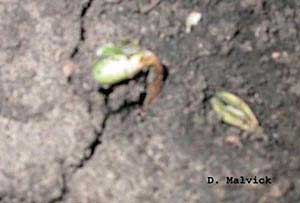Urbana, Illinois
May 20, 2004
Source
Dean Malvick
The Bulletin - Pest
management and crop development information for Illinois
Seed and
seedling diseases often dramatically influence establishment of
soybean stands. Although many soybeans remain to be planted in
Illinois, many have been planted, and the wet weather in some
areas and fluctuating temperatures may favor development of seed
and seedling diseases. This article provides a general overview
of seed and seedling diseases of soybean and describes a project
designed to enhance our knowledge of these diseases in Illinois.
Soybean
seed and seedling diseases can develop soon after the seed is
planted and continue beyond the V2 stage. Although other factors
can also cause these effects, reduced germination and/or
emergence that results in thin stands is an indication of seed
and seedling diseases. Another indication is damping-off, which
kills seedlings after emergence. These disease problems are
usually associated with wet soil conditions, although major
problems may not be noticed until a week or more after the wet
conditions occurred.
The major
pathogens that cause seed and seedling diseases of soybean are
the fungal or fungal-like pathogens Pythium,
Phytophthora, Rhizoctonia, and Fusarium.
However, we don't have a good understanding of which of these
pathogens are most common in Illinois. Please read the last
paragraph in this article to get information about a project to
help answer this question.
These
pathogens all survive and persist in soil. The tan-brown,
soft-rot symptoms on roots and stems caused by Pythium
and Phytophthora are similar and are difficult to
differentiate without laboratory testing. Reddish to dark brown
lesions, often sunken, are typically caused by Rhizoctonia.
Fusarium damping-off and root rot typically causes light to dark
brown lesions. Proper diagnosis of the major problem can help
with determining best management practices.

Infection of soybean hypocotyl by Phytophthora or
Pythium.
Once a
problem with seed and seedling diseases of soybean is noted,
several management options can be considered this year and in
the future. Whether or not to replant is based on several
factors, including the magnitude of the stand reduction and the
planting date. Additional information on replanting decisions
can be found in the Illinois Agronomy Handbook, which is
available from University of Illinois Extension. If the decision
is made to replant due to loss from disease, fungicidal seed
treatments and perhaps a cultivar with good resistance to
Phytophthora should be considered.
Seed
treatments will sometimes provide a significant benefit, while
at other times they don't provide a clear benefit. Influential
factors include planting date, history of seed and seedling
diseases, types of seed and seedling diseases present, risk
tolerance, soil compaction, seeding rates, field drainage, and
tillage.
Seed
treatments differ in activity against various seed and seed
rotting pathogens. The systemic compounds Allegiance-FL and
ApronXL are most effective for control of the "water-mold"
pathogens Phytophthora and Pythium. The other
group of fungicides, including Rival, Maxim-4FS, captan, and
several other products, protect against Fusarium,
Rhizoctonia, and other true fungal pathogens. Azoxystrobin
is a new systemic fungicidal seed treatment that recently became
available for soybean in the product SoyGard, primarily for
control of Rhizoctonia and perhaps Fusarium. For
full-spectrum control of different pathogens, combinations of
these products are often used. In addition, a biological
fungicide (Yield Shield) is available to protect soybean seed
against Fusarium and Rhizoctonia.
We have
limited information on which seed and seedling pathogens of
soybean are commonly causing problems in Illinois. We have
initiated a project to get more information about these
pathogens in Illinois and are requesting your help. We want
samples of soybean with seedling diseases from anywhere in
Illinois to determine which pathogens are causing problems. If
you visit fields or get calls regarding soybean disease at the
seedling or stand establishment stage, please collect plants or
have plants collected (10 plants per field, along with exact
location, soybean variety, and seed treatment if any). Send them
to Dean Malvick, University of Illinois, Department of Crop
Sciences, N533 Turner Hall, 1102 South Goodwin Avenue, Urbana,
IL 61801. Results will be reported next fall or winter. |